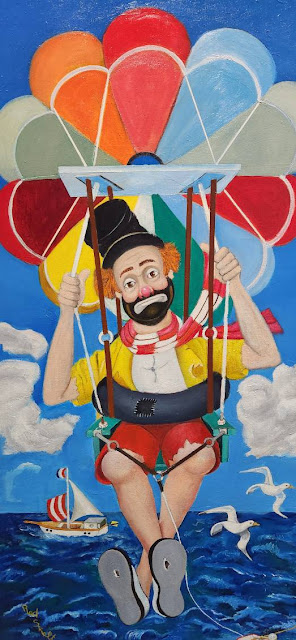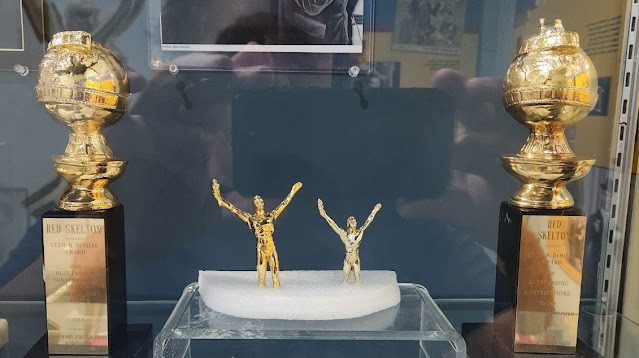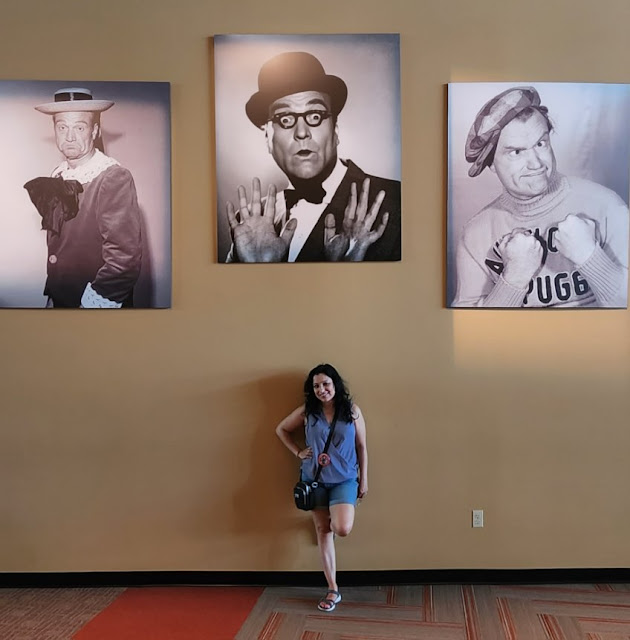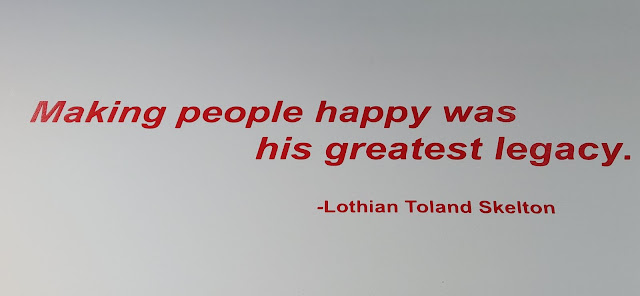"If I can make people smile, then I have served my purpose for God"- Red
Skelton
Richard Bernard "Red" Skelton, the comedic legend, was born on this day, July 18th, back in 1913. Hailed for his dynamic expressions and golden heart, he was truly a comedy genius. Skelton held audiences captive with his simple yet patriotic brand of humor and charming stage persona that drew deeply from the clown tradition. He left his mark not just in live performances, but also through radio and television broadcasts. Just last month, I had the wonderful opportunity to meet Lothian - Skelton's wife and daughter of the famous cinematographer Greg Toland, renowned for his work in 'Citizen Kane' and 'The Best Years of Our Lives'. This encounter took place at the annual festival in Vincennes, Indiana, Skelton’s hometown, which proudly celebrates the legacy of their beloved comedian each year. What an incredible experience it was!
Even though I was running late to the Clown Parade, I was able to capture a few end moments and funny clown antics. The parade route culminates at the Red Skelton Museum of American Comedy. This is a real treat if you're a fan, as there you are able to take snaps of fellow fans dressed up as Skelton's well-known TV characters.
As I was about to explore the exhibits, I struck up a conversation with a delightful woman, both of us adorned with Red Skelton festival buttons. To my surprise, she introduced herself as Lothian, the late Red Skelton's wife! Our chat was heartwarming. Her love for Skelton's fans and determination to maintain his legacy was evident. What took me by surprise was her own connection to golden era Hollywood, being the daughter of honored cinematographer, Greg Toland. He was well-regarded for his contributions to cinematic classics like Orson Welles' Citizen Kane, William Wyler's The Best Years of Our Lives, and John Ford's The Grapes of Wrath.
 | |||||||||||
| Lothian Toland Skelton |
The museum primarily serves as an homage to Skelton, yet also acts as an extensive resource on the history of American comedy. The guests are accommodated in a small theater where they are presented with a highly professional introductory documentary about Skelton and his place in the dynamic history of American comedy. After that, guests can explore various exhibits showcasing the original costumes worn by Skelton for different characters on television. Accompanying each exhibit is footage that provides insights into the character, including standout moments from their TV career. The museum brilliantly leverages digital media to narrate Skelton's story, alongside an impressive display of artifacts. Numerous hands-on and interactive exhibits contribute to a fun and engaging experience for both children and adults.
Additionally, the museum houses an exhibit detailing Skelton's position on keeping "under God" in the Pledge of Allegiance - a phrase he remembered learning as a young boy in Vincennes. Moreover, the museum features exhibits that shed light on Skelton's interests beyond comedy. These highlight his artistic talent and written works, offering a comprehensive look into the man behind the comedic genius.
 |
| Art by Red Skelton |
 | ||||||
1978 Cecil B. DeMille Award. First one, the top was broken off by Red, then replaced by the second which was broken off again!
|
Since 2006, Vincennes, Indiana, proudly remembers Red with a festival. The Red Skelton Performing Arts Center was dedicated in February 2006 on the campus of Vincennes University, one block from the home in Vincennes where Skelton was born. The building includes an 850-seat theater, classrooms, rehearsal rooms, and dressing rooms. Its grand foyer is a gallery for Skelton's paintings, statues, and film posters. The theater hosts theatrical and musical productions by Vincennes University, as well as special events, convocations, and conventions. The adjacent Red Skelton Museum of American Comedy opened on July 18, 2013, attended by fans, Skelton's widow, Lothian, daughter, Valentina Skelton Alonso and Jamie Farr. Throughout the years Crystal Gayle, The Smothers Brothers and Debbie Reynolds also visited. It houses his personal and professional materials, which he had collected since the age of 10, in accordance with his wishes (that they be made available in his hometown for the public's enjoyment). Lothian, the wife of Skelton, pointed out that he didn't fancy any Hollywood-style memorials. The funding for the museum is a joint venture between the Red Skelton Museum Foundation and the Indiana Historical Society. Plus, they didn't stop there; they also purchased and maintained his childhood home as well as other special spots.

Red's History
Joe, the father of Red, passed away two months prior to his birth, which left his mother, Ida Mae, solely responsible for bringing up Red and his three brothers. Throughout his early life, Red faced challenges such as financial instability and frequent bullying by his siblings. Yet, in spite of these difficulties, he is remembered as a caring and playful jester who always aimed to induce joy in others. To contribute to his family's income, Red engaged in various small jobs and sold newspapers, an endeavor he began at just seven years old. In 1923, an individual purchased all copies of the day's paper distributed by Skelton, intending to quiet Skelton. He then invited Skelton to watch the newest local show, even promising him a behind-the-scenes tour. It was the first time Skelton had an encounter with the theater industry - the individual turned out to be the famed comedian, Ed Wynn.

When he was 15 years old, Red embarked on a journey into the world of entertainment, performing in medicine shows, vaudeville, burlesque, and minstrels. The year 1937 saw Red making his first mark in the spheres of radio and Broadway, where his comedic skills were quickly recognized. In the course of the 1940s, "The Red Skelton Show" became a customary feature on radio. Simultaneously, Red continued to expand his horizons by appearing in films for MGM. Memorable scenes from this point in his career include his "Whistling" series in the 1940s and the endeared duet "Baby, it's Cold Outside" with Betty Garrett in the film, "Neptune's Daughter." Throughout WWII, Red's services extended beyond entertainment; he served in the US Army and ensured the morale of troops by performing comedy shows. In 1951, he played a significant role in promoting television with the launch of "The Red Skelton Show". This program enjoyed a long run of 20 years with multiple Emmy Awards to its name. Red never squandered an opportunity for creativity, establishing himself as an abundant artist, writer, and composer of music. Even in his later years, he maintained an active stage presence, performing at numerous colleges, casinos, and theaters.
My funny bone was tickled the entire time I was there. His contribution to our lives brought a newfound respect in me for him, particularly during a period when we deeply required laughter - a need that remains essential to this day!



























